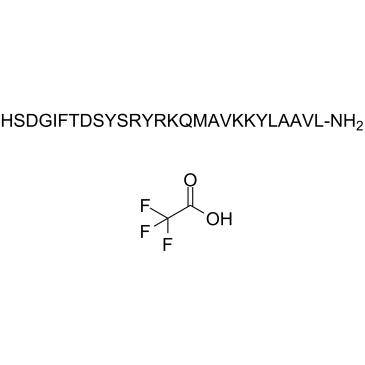PACAP (1-27), human, ovine, rat TFA (Synonyms: PACAP 1-27 TFA) |
| Catalog No.GC38596 |
PACAP (1-27), human, ovine, rat TFA (PACAP 1-27 TFA) is the N-terminal fragment of PACAP-38, and is a potent PACAP receptor antagonist with IC50s of 3 nM, 2 nM and 5 nM for rat PAC1, rat VPAC1 and human VPAC2, respectively.
Products are for research use only. Not for human use. We do not sell to patients.

Sample solution is provided at 25 µL, 10mM.
PACAP (1-27), human, ovine, rat TFA (PACAP 1-27 TFA) is the N-terminal fragment of PACAP-38, and is a potent PACAP receptor antagonist with IC50s of 3 nM, 2 nM and 5 nM for rat PAC1, rat VPAC1 and human VPAC2, respectively[1].
Radioligand receptor binding assays with I-monoiodinated PACAP (1-27), human, ovine, rat confirms the presence of PAC -receptors on AR4-2J cells, since PACAP (1-27), human, ovine, rat and PACAP(1-38) equipotently displaces radioligand binding with a Kd of 1-2 nM, whereas vasoactive intestinal peptide (VIP) is 1000-fold less potent. PACAP (1-27), human, ovine, rat exhibits a distinct and much higher susceptibility to VIP-amino acid substitutions. PACAP (1-27), human, ovine, rat has potency and binding affinity to stimulate IP3 and cAMP formation in AR4-2J cells[2].
The inhibitory effect of pituitary adenylate cyclase activating polypeptide (PACAP (1-27), human, ovine, rat) on the increase in total pulmonary resistance (RL) causes either by allergen or histamine in anaesthetized, ventilated guinea-pigs is studied. PACAP (1-27), human, ovine, rat given via i.v. infusion (0.045-4.5 nmol/kg/min) dose-dependently reduces the increase in RL caused by inhaled ovalbumin and histamine. At the highest dose, PACAP (1-27), human, ovine, rat prevents the increase in RL caused by ovalbumin and histamine completely. Infusion of PACAP (1-27), human, ovine, rat and the β2-adrenoceptor agonist, salbutamol (0.045-4.5 nmol/kg/min) inhibit the increase in RL similarly, but salbutamol increases the heart rate more than PACAP (1-27), human, ovine, rat[3].
[1]. Gourlet P, et al. Fragments of pituitary adenylate cyclase activating polypeptide discriminate between type I and II recombinant receptors. Eur J Pharmacol. 1995 Dec 4;287(1):7-11. [2]. SchÄfer H, et al. Structural motifs of pituitary adenylate cyclase-activating polypeptide (PACAP) defining PAC1-receptor selectivity. Regul Pept. 1999 Feb 5;79(2-3):83-92. [3]. LindÉn A, et al. Inhibition of bronchoconstriction by pituitary adenylate cyclase activating polypeptide (PACAP 1-27) in guinea-pigs in vivo. Br J Pharmacol. 1995 Jul;115(6):913-6.
Average Rating: 5 (Based on Reviews and 21 reference(s) in Google Scholar.)
GLPBIO products are for RESEARCH USE ONLY. Please make sure your review or question is research based.
Required fields are marked with *




















